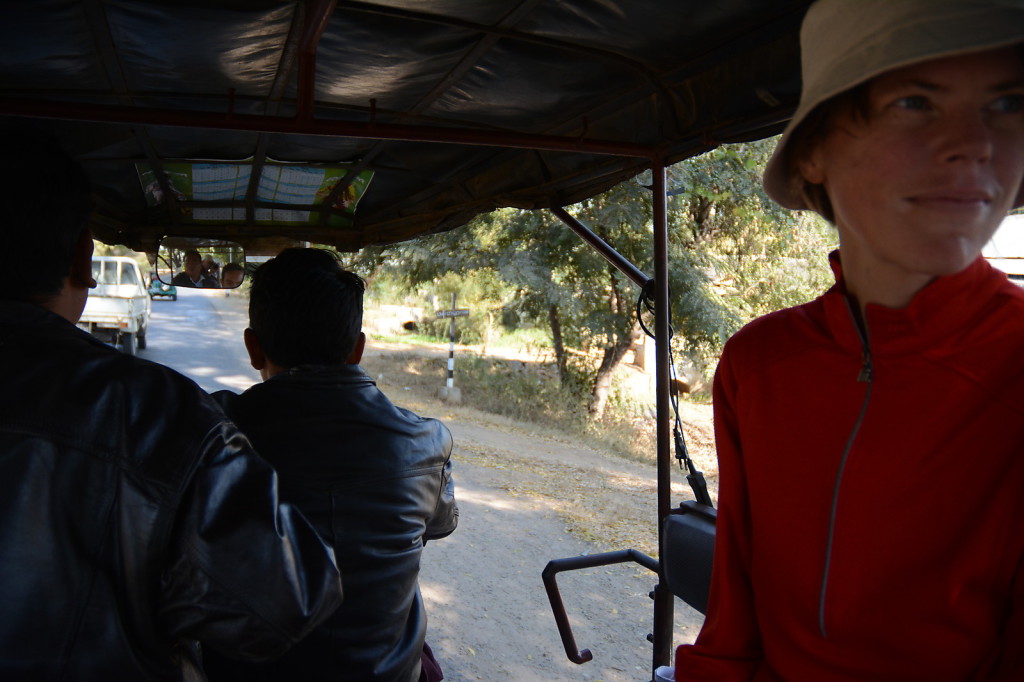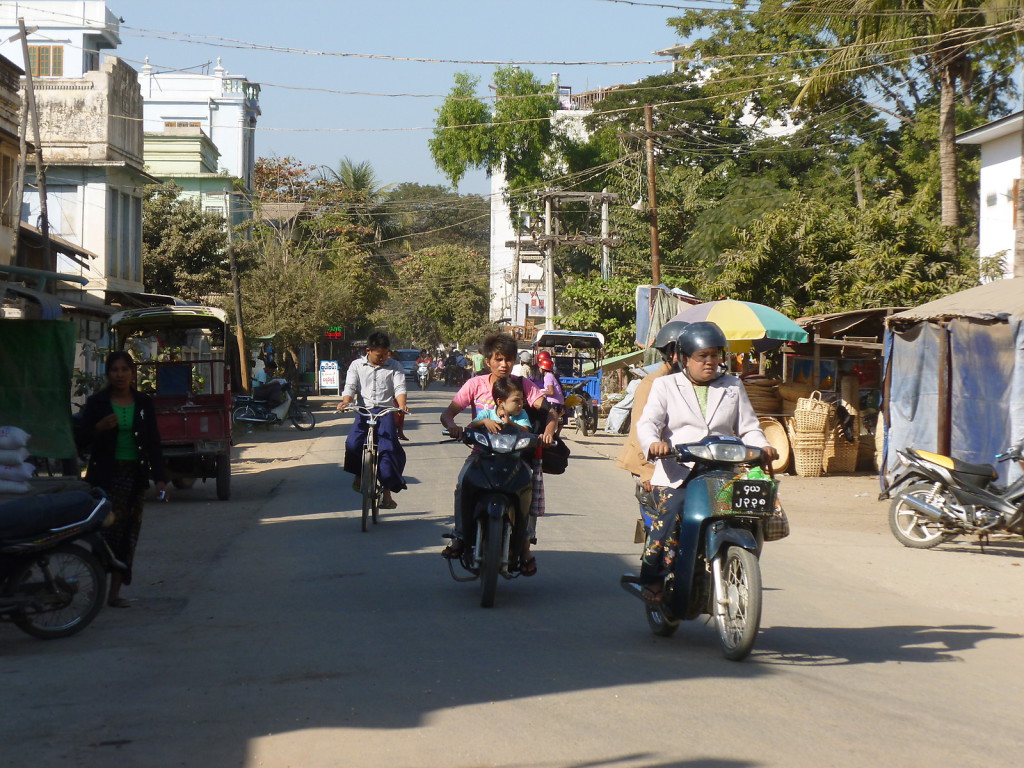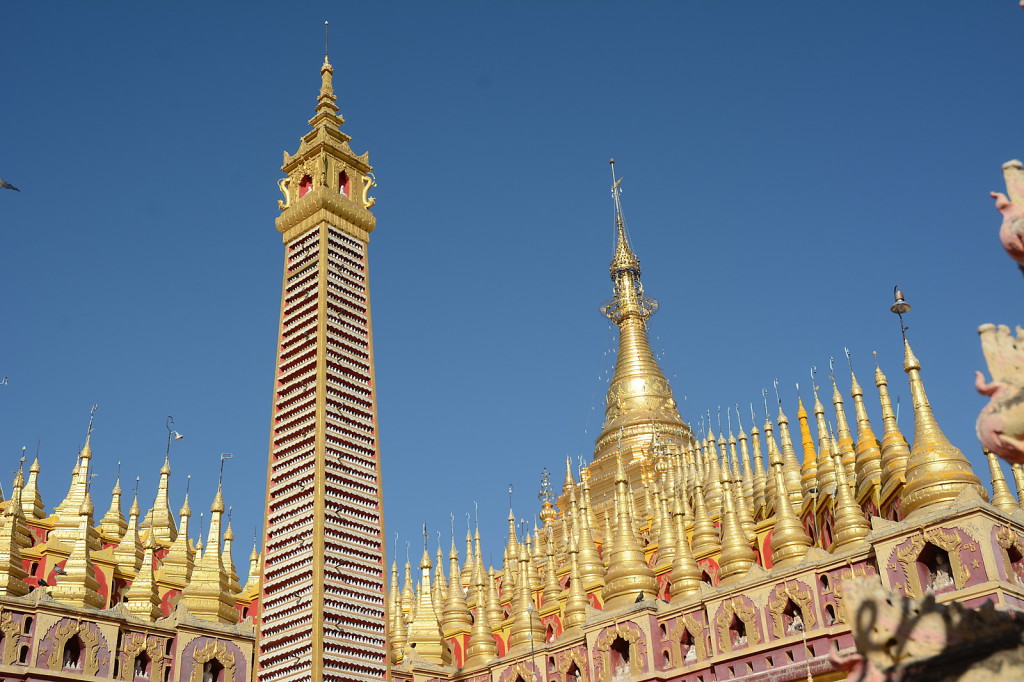While Bagan certainly had a few more things to offer, we had had our share of pagodas for this visit after one day of cycling through a large part of them. We decided to spend our last days in Myanmar in the cities of Monywa and Mandalay. Following another bumpy bus ride of around 4 hours, we first got lost in the dusty streets of the town. The next day we planned to explore the surroundings of this not so well visited city.
We enjoyed our last breakfast on the terrace on top of the Golden Myanmar Guesthouse in Nyaung Oo, before we headed out to the bus station. The morning sun, which was shining in our faces, lit up the small town in a nice golden color, which led to a very interesting scenes with the dust and motorcycles on the road. Finally we were back at the ticket counter where we had bought the tickets to Monywa the night before. Since we had waited for more than an hour in Kalaw, before the bus took off, we weren’t surprised here that the bus was about half an hour late. We were happy to find out that there was just enough room for our legs, so the ride wouldn’t be too painful.
The bus crossed and then followed the Ayeyarwaddy to the town of Pakkokku where we had a stop of a few minutes, before continuing the Chindwin River to Monywa. We crossed each of the rivers and the bridges seems way bigger than was necessary, given the low water levels during the dry season. The riverbeds also seems rather empty for both of the rivers. We thought it might be interesting to come back during the rainy season one year to observe the difference.
In a small village just past Pakkokku the bus stopped and our bus was immediately surrounded by many ladies selling something to eat. Even though we didn’t exactly know what they were selling, we bought a couple of pieces of the white cake. Once again at 11:30am sharp, the bus pulled up to a restaurant, so that people could eat their lunch. We decided to try the cakes we had just bought and determined that it was coconut cake. Delicious!
A short while later we arrived in Monywa. Together with a German tourist we negotiated with a trishaw driver on a good price to a hotel in the city center. It turned out that this was the same hotel which is listed in all guide books… We were able to negotiate a half-way good price for a decent room and immediately started our discovery tour through the city center. After finding a number of small pagodas, we eventually arrived at the big market. Markets always are a great opportunity to discover what people eat and what they buy. We ended up in the wholesale section of the market: there were shops selling only one product per shop. It was common to see potatoes and onions.
The way people were watching and observing us around the city and the market in particular, we could tell that not many foreigners got lost in this area of the country. So it happened in one shop that a few girls were playing with smartphone and tablet. They immediately wanted to take out pictures, to which we agreed. However revenge is sweet, so they got their picture taken too.
In a nice, vegetarian, alcohol-free restaurant across the street from our hotel we found some delicious dinner. The choice for the meal was easy, because there wasn’t much. However we really started to love the Myanmar tomato salad: sliced tomatoes, garnished with crushed peanuts and sesame with some vinegar sauce. The salad in that restaurant turned out to be the best in all Myanmar (at least of the ones we had).
The following day we had planned to visit the sights around Monywa: the Buddha caves of Pho Win Daung, the colorful monastery of Thanboddhay and the giant Buddha of Boddhi Tataung. In order to get to all these places, we had to find an appropriate means of transportation. Motorbikes were ruled out quickly, since it wouldn’t be fun to spend hours on the back of a motorbike. We walked up to one corner where we were hoping to find drivers who offered more than two motorized wheels. A first trishaw driver offered to take us around for 45 US$. After a while of negotiation, he offered the ride for 40 US$. A car driver approached us an offered the same trip for 60 US$, later 50. Fortunately we had learned how negotiation works in Myanmar: instead of walking away, like the Chinese do, we stood there and repeated what we were looking for. Every now and then somebody would jump out and make an offer. After no more than 10 minutes, a trishaw driver approached us and offered to take us to the three sites for 30 US$. While we knew we would be spending quite a bit of time on the slow vehicle, we agreed to the deal.

Means of transport for two tourists for a day; It was great travelling slowly to better observe villages and country-side
Very soon we realized two things: firstly, the ride would indeed be a very long one and secondly, it would actually be much nicer going slow, since this gave more time to enjoy the country-side we would be driving through. We enjoyed the wind blowing around our heads, which kept us partially cool even in the blazing afternoon sun. After about 2 hours across the large Chindwin River bridge, through palm-tree plantations , past copper mines and through a forest, we eventually arrived at Pho Win Daung.
We did not only find the entrance, where we once again paid more than a meal as an entrance fee, but also an honorary guide who immediately offered to take us around. While he did seem a bit dubious, it turned out that he was absolutely harmless. While his explanations were very basic (caves were either from the 9th, 13th or 14th century which deviated a bit from our sources), he led us straight to the most beautiful and rewarding caves. This way we got to see the, sometimes heavily renovated, but nevertheless striking, paintings in these Buddha caves.
To reach the other sights, we had to head back East to Monywa before continuing on the other side of town to Thanboddhay. For a safe ride, a monk joined us and explained a few things in his very limited English. He could tell us that the trucks we were seeing belonged to gold and copper mines, either operated by the Japanese or the Chinese. Our driver had chosen a slightly different route on the way back to town: to avoid the detour across the Chindwin he had chosen to try the ferry across the river.
Usually the little ferries crossed the river very frequently, carrying motorbikes and passengers only. Motorbikes were brought on-board across a small wooden ramp made of thin wooden boards. We observed the loading and unloading of ferries while our driver and the monk negotiated whether and for what price we could cross. The monk explained that we were a very special group, of course containing one monk and two tourists. The good news was that they let us on the ferry, the bad news was that we had to pay extra.
Loading the trishaw on the boat took a little bit of time, but went without a hitch, even though the ramp was only slightly wider than the vehicle. We enjoyed the short ride across the Chindwin River and had to wait on the other side until all the motorbikes were unloaded. Of course there were some issues when unloading the heavy vehicle, the roof got stock on one of the poles. This offered a great opportunity for the tourist to show that he can also get his hands dirty and help move the trishaw around the pole.
Having mastered this little adventure, we dropped of our monk in Monywa and headed on to the Thanboddhay Monastery. While the monastery is sometimes described as kitch, we really liked the atmosphere of the inside of the monastery, apparently containing around half a million Buddhas large and small. The outside showed a colorful Indian influence, which was quite a bit different from the gold and white we had seen so far. The whole did feel like a building out of a fairy tale.
The monastery sports quite a few crazy things: besides the thousands of Buddhas in and around the monastery, the roof is decorated with hundreds of little golden pagodas. Apparently somebody did get their dreams fulfilled here!
From Thanboddhay we headed another 7 km East to see another impressive holy site: Boddhi Tataung. Even though not quite the historic site, having been finished only in 2008, the view upon getting to the place was amazing. The golden, about 130m tall statue stood high on a hill contrasting quite nicely with the blue sky. The closer we got, the more impressive the statue became.
We first climbed up to the pagoda in front of the two Buddhas to enjoy the view of the standing and the reclining Buddhas. Once we had mastered the final steps, we almost broke our necks trying to see first the reclining Buddhas head and then the standing one’s. Unfortunately it was already almost 5pm, such that we were not allowed anymore to climb the standing Buddha. Nevertheless we enjoyed the view across the plains below and the new sleeping Buddha, which is under construction at the bottom of the hill. Just his feet looked like they were a few dozen meters tall.

Even the reclining Buddha at Boddhi Tataung is pretty big (Bonus question: Can you find Lenka in the picture?)
On our way back to the hotel, we asked our driver to drive by the bus station, such that we could buy some tickets for the next day’s ride to Mandalay. Even though we had spent a large part of the day on the trishaw, we did not feel exhausted at all. We had another day during which saw and learned a lot about the country.
Once we had showered back at the hotel, we found a noisy restaurant to eat dinner, before hitting bed for a relaxing sleep…










